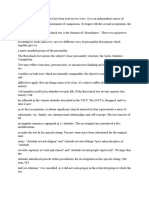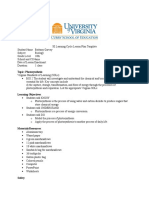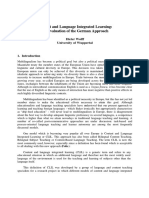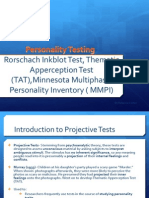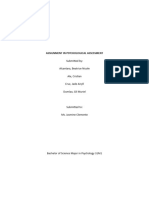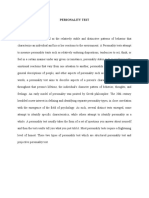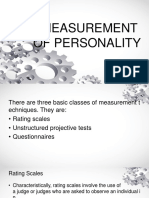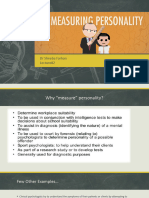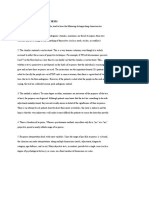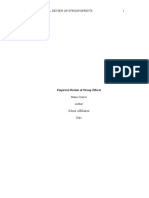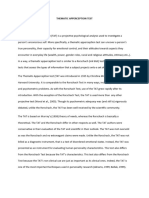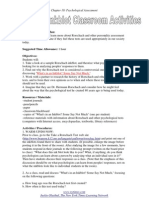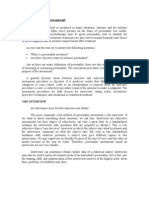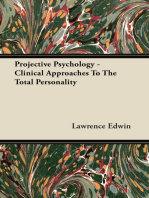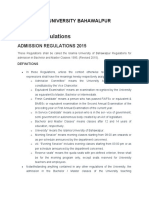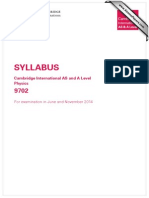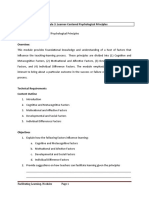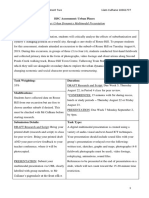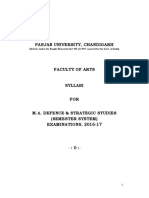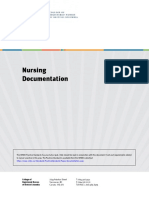Professional Documents
Culture Documents
COURSE: Educational Measurement and Evaluation (6507) Assignment No 2
COURSE: Educational Measurement and Evaluation (6507) Assignment No 2
Uploaded by
Sindhu JattOriginal Description:
Original Title
Copyright
Available Formats
Share this document
Did you find this document useful?
Is this content inappropriate?
Report this DocumentCopyright:
Available Formats
COURSE: Educational Measurement and Evaluation (6507) Assignment No 2
COURSE: Educational Measurement and Evaluation (6507) Assignment No 2
Uploaded by
Sindhu JattCopyright:
Available Formats
COURSE: Educational Measurement and Evaluation (6507)
ASSIGNMENT NO 2
QNO1: Describe the different projective methods of measurements. Provide examples for
the explanation of each method separately.
ANS: Projective techniques or tests are one of the most frequently used and important tests in
clinical work. They largely originated within a clinical setting and have retained important tools
for the clinician. Some have evolved from therapeutic procedures such as art therapy employed
with psychiatric patients.
Though projective techniques have been used since long they gained their popularity from an
article written by L. K. Frank titled “Projective Methods for the Study of Personality.” Projective
methodology’s greatest boon came in 1921 with a report by Herman Rorschach in which he
described a technique for determining modes of behaviour from an individual’s verbal responses
to a set of 10 inkblots.
Today, the literature on projective techniques is vast, running over 4,000 references on
Rorschach alone. Projective techniques are being used intensively in all areas of applied
psychology ranging from hospitals and clinics to personnel selection or vocational guidance.
Projective techniques refer to a group of techniques used for studying both intellectual and non-
intellectual aspects of personality. In these tests, an individual is presented with a relatively
unstructured or ambiguous task like a picture, inkblot or incomplete sentence which permits a
wide variety of interpretations by the subject.
Kashmir Academy 0345-5395288; WhatsApp: 0312-5043992
The basic assumption underlying projective tests is that individual’s interpretation of the task
will project his characteristic mode of responses, his personal motives, emotions and desires and
thus enable the examiner to understand more subtle aspects of his personality.
There are a wide variety of projective techniques. The two most important representative tests of
projective techniques are the Rorschach Inkblot Test and the Thematic Apperception Test. Some
other well-known projective tests include the word-association or free-association test and the
sentence completion tests.
(a) The Rorschach Inkblot Test:
Was developed by Herman Rorschach in 1921 in his Monograph “Psychodiagnostik.” He died in
the same year. His associates Emil Oberholzer, Waller Morgenthaler and George Roemer played
an important role in popularising this test.
Today Rorschach is one of the most frequently used, very popular, widely criticised and
extensively researched tests. Various innovations in this test have led to the development of
multiple systems of test administration, scoring and interpretation.
The Rorschach test consists of 10 cards having bilateral symmetrical inkblots. Half of the cards
are black and while and half are coloured. The cards are presented to subjects in a definite
sequence.
The scoring of the test is highly subjective. Several scoring categories for Rorschach test have
been developed but the most commonly scored categories are location (i.e. the area of the blot
which has been perceived by the subject on the basis of live response), determinant (i.e. charac-
2
Kashmir Academy 0345-5395288; WhatsApp: 0312-5043992
teristic of the inkblot as perceived by the subject), content (what is actually seen by the subject),
original or popular (this category tells us whether subject’s responses are common or original).
Rorschach test has received mixed reception. Some have regarded it as an X-ray of personality,
an indispensable tool for diagnostic purpose, whereas others have regarded its use as unethical.
Researchers have consistently presented a poor picture of Rorschach whereas; on the other hand
clinicians have been using this test with increasing frequency.
(b) The Thematic Apperception Test (TAT):
The only other projective technique that has approached the Rorschach method in amount of use
and volume of research is the TAT which was developed by C. D. Morgan and Henry A. Murray
in 1935 as a method to explore unconscious thoughts and fantasies.
The TAT test consists of 30 pictures and a blank card. The pictures have been selected and
marked in such a way that there are four sets of 20 cards each, one for boys, one for girls, one for
males and one for females over 14 years. The testing process is divided into two sessions and for
each of these it is suggested that no more than 10 TAT cards be administered with at least one
day intervening between the two sessions.
More recently, practical considerations have led to reduction in the number of cards
administered. Most testers now present the subject with 8 to 12 cards and use only a single
session. The cards are presented individually and the respondent is instructed to provide a story
about the picture that describes the depicted scene, what led up to it, what the characters in the
picture are thinking and what the outcome will be.
Kashmir Academy 0345-5395288; WhatsApp: 0312-5043992
Although typically administered as an oral test in clinical situations, the TAT may also be
administered in writing and as a group test.
The TAT test, like the Rorschach test; also has multiple scoring systems. The three well-known
and popular TAT scoring systems are as follows:
(a) Murray’s scoring system (Non-quantitative)
(b) McClelland’s system (quantitative) and
(c) Eron’s system (quantitative).
Since its original publication, many modifications of the original TAT test have been devised.
One such modification is the Children’s Appreciation Test (CAT).
(c) The Word Association Test:
Was originally known as the free- association test and was first developed systematically by Carl
Jung. Later on the, Kent and Rosanoff used it for psychiatric screening. There have been many
versions of the word association test. Jung’s word association test consisted of 100 words. In
1968, Rapaport and his associates developed a word-association test consisting of a list of 60
words. Kent and Rosanoff developed a word-association test consisting of 100 words to
differentiate between mentally ill and normal persons.
In the word-association test, the subject is told that the examiner would speak a series of words,
one word at a time, and he/she (the subject) should immediately say the first word which comes
to his mind and that there are no right or wrong answers.
4
Kashmir Academy 0345-5395288; WhatsApp: 0312-5043992
The examiner then records the reply to each word spoken by him, the reaction time and any
unusual speech or behaviour manifestations which might accompany a given response. The
subjects give clues for evaluating the individual’s personality.
(d) Sentence Completion Test:
In this test, the individual is presented with a series of incomplete sentences, generally open at
the end, to be completed by him in one or more words. They resemble the word-association test.
However, sentence completion test is regarded as superior to word association test because the
subject may respond with more than one word, greater flexibility and variety of responses is
possible and more areas of personality and experience may be tapped.
QNO2: What is meant by anxiety. As a teacher what measures you suggest to reduce the
test anxiety of students.
ANS: The American Psychological Association (APA) defines anxiety as "an emotion
characterized by feelings of tension, worried thoughts and physical changes like increased blood
pressure."
Knowing the difference between normal feelings of anxiety and an anxiety disorder requiring
medical attention can help a person identify and treat the condition.
In this article, we look at the differences between anxiety and anxiety disorder, the different
types of anxiety, and the available treatment options.
Kashmir Academy 0345-5395288; WhatsApp: 0312-5043992
When an individual faces potentially harmful or worrying triggers, feelings of anxiety are not
only normal but necessary for survival.
Since the earliest days of humanity, the approach of predators and incoming danger sets off
alarms in the body and allows evasive action. These alarms become noticeable in the form of a
raised heartbeat, sweating, and increased sensitivity to surroundings.
The danger causes a rush of adrenalin, a hormone and chemical messenger in the brain, which in
turn triggers these anxious reactions in a process called the "fight-or-flight' response. This
prepares humans to physically confront or flee any potential threats to safety.
For many people, running from larger animals and imminent danger is a less pressing concern
than it would have been for early humans. Anxieties now revolve around work, money, family
life, health, and other crucial issues that demand a person's attention without necessarily
requiring the 'fight-or-flight' reaction.
The nervous feeling before an important life event or during a difficult situation is a natural echo
of the original 'fight-or-flight' reaction. It can still be essential to survival – anxiety about being
hit by a car when crossing the street, for example, means that a person will instinctively look
both ways to avoid danger.
Anxiety disorders
The duration or severity of an anxious feeling can sometimes be out of proportion to the original
trigger, or stressor. Physical symptoms, such as increased blood pressure and nausea, may also
develop. These responses move beyond anxiety into an anxiety disorder.
6
Kashmir Academy 0345-5395288; WhatsApp: 0312-5043992
1. Ask students where their fear is coming from
Having a better understanding of why a student is experiencing test anxiety can be hugely
helpful in figuring out the best way to manage it. Some students will be able to articulate their
feelings better than others, but regardless, asking the question will provide valuable clues as to
what will help calm a student down.
2. Keep things in perspective
In the grand scheme of things, no single test is going to define a student’s academic career, or
have that significant of an impact on their future. After all, it’s just one test. As an adult, it’s
probably much easier for you to understand this perspective than it is for your students—you’ve
had more experience with both failure and success, realize they both happen, and know that no
matter what, the world keeps turning. Share this perspective with your students regularly,
offering gentle reminders that every test is just a test, and no test defines how smart, successful,
or worthy they are.
3. Prioritize classroom preparation efforts
Studying and preparing beforehand are two things that students really do have control over when
it comes to testing, and they can bring a lot of confidence and peace of mind. Make sure you go
in to testing season with a well-thought-out review plan to give your students plenty of chances
to brush up on knowledge and skills they’ll be assessed on. It’s also very helpful to get your
students comfortable with the type of test environment they’ll experience. If tests will be taken
Kashmir Academy 0345-5395288; WhatsApp: 0312-5043992
online, make sure your students are familiar with the kind of devices they’ll use and
any technology-enhanced item types they’ll encounter. Consider offering extra review
opportunities outside of class as well—bagel breakfasts, after-school snack sessions, or open
office hours during prep periods are all low-pressure options that anxious students looking for
some additional practice will appreciate.
4. Teach effective test-taking strategies
Test taking is a skill in and of itself. Help calm anxious students’ nerves by making sure they are
familiar with and have confidence in test-taking skills as well as the actual content they’re being
tested on. Some of these best practices include reading questions completely before answering
them (especially for tricky technology-enhanced item types), skipping over questions that
students don’t know in order to manage time, and reviewing answers as time allows.
5. Focus on the positives
Students struggling with test anxiety are wrapped up in patterns of negative thinking when it
comes to tests. They’re focusing on all of the mistakes they could make, everything that could go
wrong, and how catastrophic a bad score could be. Shift their focus by helping them reflect on
some positive past experiences. Ask them to tell you (or journal) about a test that they did well
on. What did they do leading up to that test? How did they feel about it before and after? Getting
a student to stop and remember their own abilities can go a long way toward breaking the
negativity cycle—and calm nerves in the process.
6. Empower students with simple strategies to reduce anxiety
8
Kashmir Academy 0345-5395288; WhatsApp: 0312-5043992
For many students with test anxiety, the truly difficult moments don’t hit until they’ve sat down
to take their test. Basic anxiety-reducing techniques can be a big help for these students.
Encourage your learners to practice simple deep breathing exercises, use positive self-talk and
mantras, or do seated stretches to release tension once the test is underway.
7. Help students create a study schedule
Some students who struggle with test anxiety spend countless hours studying, reviewing, and
cramming in frantic efforts to get ready for exams. While preparation is certainly key, it’s
important to be intentional about how to go about it. Try helping your students create study
schedules to follow at home. Encourage them to block out reasonable blocks of time during their
week, taking in to account other homework, extracurricular activities, and time for fun and
relaxation. Having a schedule to follow can help kids manage stress, feel confident in their
preparation efforts, and make more productive use of their study time.
QNO3: Write down learning outcomes for any unit of science for 9th class and develop an
Essay type test items with rubric, 5 multiple choice questions and 5 short questions for
written learning outcomes.
ANS:
QNO4: Describe the measures of relationship. Also elaborate how these measures can be
utilized in the interpretation of test results? Provide example where necessary.
Kashmir Academy 0345-5395288; WhatsApp: 0312-5043992
ANS: The measure of relationship are those statistical measures that we use in context of
univariate population i.e., the population consisting of measurement of only one variable. But if
we have the data on two variables, we are said to have a bivariate population and if the data
happen to be on more than two variables, the population is known as multivariate population. If
for every measurement of a variable, X, we have corresponding value of a second variable, Y,
the resulting pairs of values are called a bivariate population. In addition, we may also have a
corresponding value of the third variable, Z, or the forth variable, W, and so on, the resulting
pairs of values are called a multivariate population. In case of bivariate or multivariate
populations, we often wish to know the relation of the two and/or more variables in the data to
one another. We may like to know, for example, whether the number of hours students devote
for studies is somehow related to their family income, to age, to sex or to similar other factor.
There are several methods of determining the relationship between variables, but no method can
tell us for certain that a correlation is indicative of causal relationship.
In a study of relationships between variables, we can often (but not always) distinguish between
two types of variables:
The response variable (also called the dependent variable) is the variable you are studying.
An explanatory variable (also called the independent variable) is any variable that you measure
that may be affecting the level of the response variable. An explanatory variable is also
commonly termed a factor in an experimental study, or a risk factor in an epidemiological study
In many studies the distinction between response and explanatory variables is quite clear. Let's
take as an example an epidemiological study of the disease cysticercosis in a
10
Kashmir Academy 0345-5395288; WhatsApp: 0312-5043992
rural population. The aim is to determine if there is a relationship between anyone having
cysticercosis in a household, and the keeping of pigs in the compound. Here the explanatory
variable (risk factor) is whether or not pigs are kept, and the response variable is infection status.
But sometimes this distinction cannot be made - for example you might want to assess the
relationship between eye colour to hair color. It is hard to argue that eye colour affects hair
colour, or vice versa, although the two may be associated in some way.
Ratios for summarizing relationships
Epidemiologists often need to summarize relationships between nominal variables, because both
the response and explanatory variables they study are usually nominal, and often binary - for
example whether an individual has a disease or not, and whether that person smokes or not.
Hence will use their terminology for the methods we examine - but remember that the same
designs can be (and are being) used in other disciplines. The response variable is commonly
either a measure of disease frequency, or a measure of mortality. The ratios used are either a risk
ratio, an odds ratio, or a rate ratio. For some study designs, only one type of ratio is appropriate
QNO5 (a): Describe the purposes and methods of assigning grades.
ANS: The first step in sound classroom assessment practices associated with grading is to ensure
that grades are meaningful. In determining students’ grades, teachers typically merge scores from
major exams, compositions, quizzes, projects, and reports, along with evidence from homework,
punctuality in turning in assignments, class participation, work habits, and effort. Computerized
grading programs help teachers apply different weights to each of these categories (Guskey,
2002) that then are combined in idiosyncratic ways (McMillan, 2001; McMillan, Myran, &
11
Kashmir Academy 0345-5395288; WhatsApp: 0312-5043992
Workman, 2002). The result often is a grade that is impossible to interpret accurately or
meaningfully (Brookhart & Nitko, 2008; Cross & Frary, 1996). To make grades more
meaningful, we need to address both the purpose of grades and the format used to report them.
Purpose and criteria
The purpose of grading is to describe how well students have achieved the learning objectives or
goals established for a class or course of study. Grades should reflect students’ performance on
specific learning criteria. Establishing clearly articulated criteria for grades makes the grading
process more fair and equitable. Unfortunately, different teachers often use widely varying
criteria in determining students’ grades, and students often aren’t well-informed about those
criteria.
Recognizing that merging diverse sources of evidence distorts the meaning of any grade,
educators in many parts of the world assign multiple grades. This idea provides the foundation
for standards-based approaches to grading. In particular, educators distinguish among the
product, process, and progress learning criteria (Guskey & Bailey, 2010).
Product criteria are favored by educators who believe grading’s primary purpose is
communicating summative evaluations of students’ achievement and performance (O’Connor,
2002). They focus on what students know and are able to do at a particular point in time.
Teachers who use product criteria typically base grades exclusively on final examination scores,
final products (e.g., reports, projects, or exhibits), overall assessments, and other culminating
demonstrations of learning.
12
Kashmir Academy 0345-5395288; WhatsApp: 0312-5043992
Process criteria are emphasized by educators who believe product criteria don’t provide a
complete picture of student learning. From this perspective, grades should reflect not only the
final results but also how students got there. Teachers who consider responsibility, effort, or
work habits when assigning grades use process criteria. The same happens when teachers count
classroom quizzes, formative assessments, homework, punctuality of assignments, class
participation, or attendance.
Progress criteria are used by educators who believe the most important aspect of grading is how
much students gain from their learning experiences. Other names for progress criteria include
learning gain, improvement scoring, value-added learning, and educational growth. Teachers
who use progress criteria look at students’ improvement over a period of time, rather than just
where they are at a given moment. Scoring criteria may be highly individualized among students.
For example, grades might be based on the number of skills or standards in a learning continuum
that students mastered and on the adequacy of that level of progress for each student.
Typically, the “achievement grade” is expressed as a letter grade or percentage that represents
the teacher’s best judgment of the student’s level of performance relative to the explicit learning
objectives for the class or course. Computations of grade point averages (GPA) and class ranks
are exclusively based on these achievement or product grades. For nonacademic factors such as
homework, class participation, effort, and learning progress, teachers typically record numerical
marks (e.g., 4 = consistently, 3 = usually, 2 = sometimes, and 1 = rarely). The development of
rubrics helps make this process explicit for students and parents. For example, in the case of
homework, teachers may use categories.
13
Kashmir Academy 0345-5395288; WhatsApp: 0312-5043992
Teachers who report multiple grades for these different criteria don’t have to worry about how to
weight or combine the grading evidence. This avoids difficult arguments about the
appropriateness of various weighting strategies. Reporting multiple grades also increases the
validity, the reliability, and the fairness of the grading process. Furthermore, to the degree that
classroom assessments of student learning are aligned with student learning outcomes addressed
in large-scale state assessments, the relationship between product or achievement grades and the
accountability assessment results will be much stronger.
Best practices: Reporting
Most states today have common standards for student learning that identify what students should
learn and be able to do. Despite these common standards in English language arts (ELA) and
mathematics, few states have developed well-aligned and effective standards-based reporting
forms that overcome multiple design and implementation issues . Kentucky, however, has
initiated a statewide effort to develop a common, standards-based student report card for
elementary and secondary grades. Kentucky also was the first state to start implementing the
Common Core State Standards. The Kentucky experience in standards-based reporting shows us:
Teachers need to know the domains or strands, clusters or organizing elements, and standards;
Teachers need to base grades on explicit criteria derived from the clearly established learning
standards that appear in the national standards; and
Furthermore, if the standards-based approach is going to work for all students, the guidelines for
reporting must consider how well it will reflect the achievement of students with disabilities and
14
Kashmir Academy 0345-5395288; WhatsApp: 0312-5043992
English language learners (Jung, 2009; Jung & Guskey, 2010). The end result is the
transformation of the traditional approach into a standards-based report card that creates a
straightforward link between curriculum and assessment.
Standards-based procedures
The first step in any standards-based reporting is to develop a deep understanding of the student
learning standards. From this, educators can develop the critical strands of standards that will be
meaningful for reporting. Typically, three to five standards in a given subject are appropriate
(Guskey & Bailey, 2001). The goal is to develop reporting standards that mirror the strands in
the ELA standards and the domains in mathematics standards.
In ELA, for example, teachers may consider the strands or subdomains of reading, writing,
speaking/listening, and language. In math, teachers consider strands associated with operations
and algebraic thinking, number and operations, fractions, measurement and data, and geometry.
Some teachers might contend that the Common Core standards apply only to ELA and math.
However, professional organizations in every subject area have established standards for student
learning that are arranged in similar strands or subdomains. For example, the National Science
Teachers Association and the National Council for Social Studies have developed their own
standards; so have the national organizations for music education, physical education, arts
education, and others.
Finally, success in grading and reporting will be augmented as Internet-based applications are
developed that allow teachers to record student performance and tally it to determine grades.
15
Kashmir Academy 0345-5395288; WhatsApp: 0312-5043992
Such applications should be teacher friendly and include procedures for printing and distributing
report cards.
Structure and format
Standards-based reporting forms that include students’ photographs add a personalized element
to the reporting process. Other demographic information such as address, class, grade level, and
school should be included as well. This demographic information is followed by the standards-
based information about a student’s school performance.
The look of the report card changes with the grade level of the student. For elementary report
cards, each subject has specific content strands so teachers can provide separate grades for each.
This requires teachers to keep more detailed records of student performance and so it gives
parents and students more specific information about a student’s learning strengths and areas of
needed growth. This process helps unpack the standards and also contributes to having more
targeted supports for students, parents, and out-of-school organizations. Rubrics are developed to
determine the marks for process learning goals related to preparation, participation, homework,
cooperation, and respect.
Another possibility is to include process goals in sections labeled work habits, study skills,
and/or citizenship. Finally, elementary school report cards need to include a section for
description/comments with two components: (a) two or three sentences explaining more
precisely the emphases of instruction during the grading period and (b) a sentence or two about a
particular student’s strengths and areas for growth. The more specific the suggestions, the more
helpful they will be to students.
16
Kashmir Academy 0345-5395288; WhatsApp: 0312-5043992
For secondary report cards, it is also important to personalize them with the names and
photographs of each student’s teachers. Merging the class schedule program with the reporting
program is essential. As with the elementary report card, there is a section dedicated to academic
achievement (product) grades for each subject area or course. These grades are used to determine
course credit and to calculate GPA. The achievement grade must be based on the evidence of a
student’s academic performance and not include nonacademic factors related to work habits or
class behavior. Standards are based on the strands or domains in each content area. In addition to
reporting on academic achievement, process goals related to participation, cooperation,
homework, and punctuality are developed. Rubrics should be available for students and
parents/guardians. The description and comment sections include general statements for the class
as well as individual comments about each student’s performance.
Report cards at both the elementary and secondary levels should allow teachers to attach custom-
scoring criteria for students who may be working on modified and/or accommodated standards.
The specific strategies developed to support these modifications can then be described in the
Individual Education Plan (IEP) for students with disabilities and the Individual Student Plan
(ISP) for English language learners. This, in turn, helps parents and youth organizations support
the targeted response-to-interventions.
Implications for grading and reporting
If assessments are graded and reported the right way, they can be a powerful tool for student
learning. Classroom assessment practices that inform instruction will be invaluable as teachers
work to implement the Common Core standards, which are meant to prepare all students for
17
Kashmir Academy 0345-5395288; WhatsApp: 0312-5043992
college and/or career. Grades should be carefully computed and summary comments should be
carefully formulated. Grades are most effective when they reflect only achievement. When
grades include other aspects of student performance (e.g., effort or progress), they have less
meaning as a summary of achievement.
Grading
Based on countless interactions with teachers, we’ve concluded that the first step in sound
classroom assessment practices associated with grades is to make them meaningful. The primary
issue is to figure out how to weight and combine different factors into the final grade and
summative comments. When the guidelines provided within the standards are applied, the
problems associated with hodgepodge grading methods may be eliminated. The standards
provide a sound alternative or grading system that can be used to replace traditional grading
practices.
The second element of the system is about identifying factors that relate to achievement in direct
or indirect ways; teachers must decide what evidence best serves the purpose. Under the
suggested system, teachers would assign separate grades for achievement, effort, and progress.
Grades become more meaningful when separate grades are assigned for each category. Grades
reflecting academic achievement are determined separately from undefined aspects of process
and progress. The end result will be not only more meaningful grades but more useful grades that
will inform teaching and learning.
18
Kashmir Academy 0345-5395288; WhatsApp: 0312-5043992
QNO5 (b): What are purposes of assigning grades to the student’s achievement and what
these grades reflect.
ANS: The grades teachers and professors assign to students’ work and performance have long
been identified by those in the measurement community as prime examples of unreliable
measurement (Brookhart, 1993; Stiggins, Frisbie, & Griswold, 1989). What one teacher
considers in determining students’ grades may differ greatly from the criteria used by another
teacher (Cizek, Fitzgerald, & Rachor, 1996; McMillan, Workman, & Myran, 1999). Even in
schools and colleges where established grading policies offer guidelines for assigning grades,
significant variation remains in the grading practices of individual teachers and professors
(Brookhart, 1994, McMillan, 2001). One reason for this variation is that few teachers or
professors receive any formal training on grading and reporting. Most have scant knowledge of
the various grading methods, the advantages and disadvantages of each, or the effects of different
grading policies (Stiggins, 1993, 1999). As a result, the majority of teachers and professors rely
on traditional grading practices, often replicating what they experienced as students (Frary,
Cross, & Weber, 1993; Guskey & Bailey, 2001; Truog & Friedman, 1996). Because personal
recollections of these experiences vary among teachers and professors, so too do the practices
and policies they employ. Despite their questionable psychometric properties, however, grades
have a powerful influence on students. Grades reflect the teacher or professors’ judgment of
students’ level of achievement and, ideally, provide students with information they can use to
improve their performance. But grades also have been shown to have strong and lasting effects
on students’ attitudes, behaviors, and motivation to learn. The grades teachers and professors
assign to students’ work and performance have long been identified by those in the measurement
19
Kashmir Academy 0345-5395288; WhatsApp: 0312-5043992
community as prime examples of unreliable measurement (Brookhart, 1993; Stiggins, Frisbie, &
Griswold, 1989). What one teacher considers in determining students’ grades may differ greatly
from the criteria used by another teacher (Cizek, Fitzgerald, & Rachor, 1996; McMillan,
Workman, & Myran, 1999). Even in schools and colleges where established grading policies
offer guidelines for assigning grades, significant variation remains in the grading practices of
individual teachers and professors (Brookhart, 1994, McMillan, 2001). One reason for this
variation is that few teachers or professors receive any formal training on grading and reporting.
Most have scant knowledge of the various grading methods, the advantages and disadvantages of
each, or the effects of different grading policies (Stiggins, 1993, 1999). As a result, the majority
of teachers and professors rely on traditional grading practices, often replicating what they
experienced as students (Frary, Cross, & Weber, 1993; Guskey & Bailey, 2001; Truog &
Friedman, 1996). Because personal recollections of these experiences vary among teachers and
professors, so too do the practices and policies they employ. Despite their questionable
psychometric properties, however, grades have a powerful influence on students. Grades reflect
the teacher or professors’ judgment of students’ level of achievement and, ideally, provide
students with information they can use to improve their performance. But grades also have been
shown to have strong and lasting effects on students’ attitudes, behaviors, and motivation to learn
20
Kashmir Academy 0345-5395288; WhatsApp: 0312-5043992
You might also like
- The Sentence Completion TestDocument6 pagesThe Sentence Completion Testabisha.angeline22No ratings yet
- First Fleet InquiryDocument14 pagesFirst Fleet Inquirytrembath.simon.g4899No ratings yet
- Sacks Sentence Completion TestDocument18 pagesSacks Sentence Completion TestMohammed RaasithNo ratings yet
- Safety Culture AssessmentDocument11 pagesSafety Culture AssessmentViny SouzaNo ratings yet
- 5e Lesson Plan RevisedDocument4 pages5e Lesson Plan Revisedapi-340842845100% (2)
- Dieter Wolff PDFDocument13 pagesDieter Wolff PDFzarkhuanNo ratings yet
- IB THEATRE Independent Project Portfolio (IPP) - Hints & Tips SheetDocument6 pagesIB THEATRE Independent Project Portfolio (IPP) - Hints & Tips SheetPNRNo ratings yet
- Methods Used To Assess PersonalityDocument7 pagesMethods Used To Assess PersonalityKaizer Aldrych Taroma EspelitaNo ratings yet
- Report On Testing - Summary OutlineDocument8 pagesReport On Testing - Summary OutlineDiana Quimpan Cillo100% (1)
- Rorschach Inkblot Test, Thematic Apperception Test (TAT), Minnesota Multiphasic Personality Inventory (MMPI)Document21 pagesRorschach Inkblot Test, Thematic Apperception Test (TAT), Minnesota Multiphasic Personality Inventory (MMPI)Devika VenkatNo ratings yet
- Rorshach Inkblot Test FileDocument11 pagesRorshach Inkblot Test FileAisha NoorNo ratings yet
- Projective TestingDocument5 pagesProjective TestingRoci ArceNo ratings yet
- RorschachDocument4 pagesRorschachcatherineyandoc37No ratings yet
- Assignment in Psychological AssessmentDocument16 pagesAssignment in Psychological Assessmentale.cristianNo ratings yet
- Psychometric Asssessment: A Psychometric Test Must BeDocument8 pagesPsychometric Asssessment: A Psychometric Test Must BePooja100% (1)
- Projective Personality TestsDocument13 pagesProjective Personality TestsTejus Murthy A G100% (3)
- Everything Interesting About Psychology in One MagazineDocument15 pagesEverything Interesting About Psychology in One Magazineneil_thebestNo ratings yet
- Persnality TestDocument4 pagesPersnality TestZeeshan KhanNo ratings yet
- Article On Projective TechniquesDocument5 pagesArticle On Projective TechniquesSergio CortesNo ratings yet
- Psychological Testing: 1.sentence Completion 2. Trending Psychological TestsDocument17 pagesPsychological Testing: 1.sentence Completion 2. Trending Psychological TestsshehbazNo ratings yet
- Personality Notes 2023Document5 pagesPersonality Notes 2023xoranek474No ratings yet
- Personality TestDocument7 pagesPersonality TestRoslina HassanNo ratings yet
- Personality TestDocument7 pagesPersonality TestRio sanNo ratings yet
- Report AssessmentDocument40 pagesReport AssessmentRace Zee BesaNo ratings yet
- The Measurement of PersonalityDocument13 pagesThe Measurement of PersonalityReygem Binayao BanilarNo ratings yet
- Projective Personality AssessmentDocument14 pagesProjective Personality AssessmentZunaira Arshad100% (1)
- Sacks Sentence Completion Test ReportDocument21 pagesSacks Sentence Completion Test Report9nczv5cfbwNo ratings yet
- 2 - Measuring PersonalityDocument21 pages2 - Measuring Personality2v464v7xk2No ratings yet
- MpiDocument7 pagesMpiVipin Yadav50% (2)
- PERSONALITYDocument51 pagesPERSONALITYBhagyashri DarjiNo ratings yet
- Copy of What's in An Inkblot Some Say Not Much ArticleDocument6 pagesCopy of What's in An Inkblot Some Say Not Much ArticleNoah LoftonNo ratings yet
- Ciccarellie Full Study GuideDocument215 pagesCiccarellie Full Study GuideNina PobleteNo ratings yet
- Personality Tests: Projective TestDocument3 pagesPersonality Tests: Projective TestSonia TauhidNo ratings yet
- Erard (2014 Aug 8) Ask The Experts - 10 Reasons To Reconsider NOT Using Rorschach in Child Custody EvaluationsDocument6 pagesErard (2014 Aug 8) Ask The Experts - 10 Reasons To Reconsider NOT Using Rorschach in Child Custody EvaluationsFlavia ChNo ratings yet
- Rotter PrinttttDocument6 pagesRotter PrinttttChhavi MudgalNo ratings yet
- Rorschach Inkblot TestDocument7 pagesRorschach Inkblot Testabisha.angeline22No ratings yet
- Privacy in Psychological TestingDocument19 pagesPrivacy in Psychological TestingNameNo ratings yet
- Rorschach InfoDocument8 pagesRorschach InfoAparna VermaNo ratings yet
- The Nature of Projective TestsDocument8 pagesThe Nature of Projective TestsNomer EspinosaNo ratings yet
- Rorschach TestDocument4 pagesRorschach TestKimberly Bacorro100% (2)
- Lie Detection TechniquesDocument62 pagesLie Detection TechniquesMelanie Garcia Canonizado100% (1)
- Empirical Review of Stroop EffectsDocument14 pagesEmpirical Review of Stroop EffectsFrank WanjalaNo ratings yet
- Projective TechniquesDocument5 pagesProjective Techniquess.tan.christineNo ratings yet
- Session 7 and 8Document16 pagesSession 7 and 8Mahika PatelNo ratings yet
- What Is A Personality TestDocument13 pagesWhat Is A Personality Testfazilabibi344No ratings yet
- Harrow Er 1950Document21 pagesHarrow Er 1950Flavia ChNo ratings yet
- Personality TestingDocument40 pagesPersonality TestingbindwasnyyadavNo ratings yet
- Itp Report Tushita TandonDocument18 pagesItp Report Tushita TandonTushitaNo ratings yet
- An Introduction To Rorschach AssessmentDocument56 pagesAn Introduction To Rorschach AssessmentJosé Carlos Sánchez-RamirezNo ratings yet
- 5 - Asesmen Klinis (Tes Proyektif)Document10 pages5 - Asesmen Klinis (Tes Proyektif)Syifa SalsabilaNo ratings yet
- JASAR KHAN Practical III EPQRDocument12 pagesJASAR KHAN Practical III EPQRZainabNo ratings yet
- THEMATIC APPERCEPTION TEST For StudentsDocument12 pagesTHEMATIC APPERCEPTION TEST For StudentsTANISHQA 2239456No ratings yet
- Projective TestDocument48 pagesProjective TestShaky253No ratings yet
- Vickie Is Doing A Research Paper On Projective Personality TestsDocument7 pagesVickie Is Doing A Research Paper On Projective Personality TestskmffzlvkgNo ratings yet
- Assignment No. 1Document14 pagesAssignment No. 1تالیہ مرادNo ratings yet
- Lie Detection TechniquesDocument47 pagesLie Detection TechniquesRamales Dhan Carlo100% (1)
- Overview of Lesson Plan:: Chapter 10: Psychological AssessmentDocument4 pagesOverview of Lesson Plan:: Chapter 10: Psychological AssessmentManoj PandeyNo ratings yet
- AP Psychology Summary Analysis Sheet Who Is Crazy Here AnywayDocument2 pagesAP Psychology Summary Analysis Sheet Who Is Crazy Here AnywayCaleb ForalNo ratings yet
- Personality Assessment: The InterviewDocument10 pagesPersonality Assessment: The InterviewgHiEmUeLNo ratings yet
- Origins of Projective Tests: How Projective Tests Are Used To Measure PersonalityDocument3 pagesOrigins of Projective Tests: How Projective Tests Are Used To Measure PersonalityZainab SheikhNo ratings yet
- Projective TestsDocument3 pagesProjective TestsAlcaraz Paul JoshuaNo ratings yet
- SCT General DiscussionDocument4 pagesSCT General DiscussionParamesh WaranNo ratings yet
- Detection of Malingering during Head Injury LitigationFrom EverandDetection of Malingering during Head Injury LitigationArthur MacNeill Horton, Jr.No ratings yet
- Projective Psychology - Clinical Approaches To The Total PersonalityFrom EverandProjective Psychology - Clinical Approaches To The Total PersonalityNo ratings yet
- Evidence-Based LaryngologyFrom EverandEvidence-Based LaryngologyDavid E. RosowNo ratings yet
- The Islamia University BahawalpurDocument11 pagesThe Islamia University BahawalpurSindhu JattNo ratings yet
- 1st Year COMPUTER CH Wise 2021 by 786 AcademyDocument10 pages1st Year COMPUTER CH Wise 2021 by 786 AcademySindhu Jatt100% (1)
- 1st Year CHEMISTRY CH Wise 2021 by 786 AcademyDocument11 pages1st Year CHEMISTRY CH Wise 2021 by 786 AcademySindhu Jatt80% (5)
- Sana Safinaz - Catalogue - Muzlin Spring Vol 1 2022Document136 pagesSana Safinaz - Catalogue - Muzlin Spring Vol 1 2022Sindhu JattNo ratings yet
- University of SargodhaDocument13 pagesUniversity of SargodhaSindhu JattNo ratings yet
- 1st Year Math 1st Test SeriesDocument16 pages1st Year Math 1st Test SeriesSindhu JattNo ratings yet
- Stock Valuation: Answers To Concept Questions 1Document15 pagesStock Valuation: Answers To Concept Questions 1Sindhu JattNo ratings yet
- 1st Year ENGLISH CH Wise 2021 by 786 AcademyDocument9 pages1st Year ENGLISH CH Wise 2021 by 786 AcademySindhu Jatt67% (3)
- Chapter 12Document14 pagesChapter 12Sindhu JattNo ratings yet
- MA Urdu, Islamic ST, Arabic, PGD & MSC Gender & Women STDocument54 pagesMA Urdu, Islamic ST, Arabic, PGD & MSC Gender & Women STSindhu JattNo ratings yet
- Some Lessons From Capital Market History: Answers To Concepts Review and Critical Thinking Questions 1Document13 pagesSome Lessons From Capital Market History: Answers To Concepts Review and Critical Thinking Questions 1Sindhu JattNo ratings yet
- 2nd Year Math 1st SeriesDocument12 pages2nd Year Math 1st SeriesSindhu JattNo ratings yet
- Dokumen - Tips - Lesson 1 and 2 CVP Question Set PDFDocument12 pagesDokumen - Tips - Lesson 1 and 2 CVP Question Set PDFSindhu JattNo ratings yet
- Problems 1-30: Input Boxes in TanDocument46 pagesProblems 1-30: Input Boxes in TanSindhu JattNo ratings yet
- Foundations of Employee Motivation: C H A P T E RDocument20 pagesFoundations of Employee Motivation: C H A P T E RSindhu JattNo ratings yet
- Purine Table and InformationDocument11 pagesPurine Table and InformationSindhu Jatt100% (1)
- Workplace, Values, Ethics, and Emotions: C H A P T E RDocument24 pagesWorkplace, Values, Ethics, and Emotions: C H A P T E RSindhu JattNo ratings yet
- COURSE: Educational Measurement and Evaluation (6507) Assignment No 1Document19 pagesCOURSE: Educational Measurement and Evaluation (6507) Assignment No 1Sindhu JattNo ratings yet
- What Am I: I.e, From Easy To Difficult. Write The Same Question NumbersDocument3 pagesWhat Am I: I.e, From Easy To Difficult. Write The Same Question NumbersSindhu JattNo ratings yet
- Assignment 622 MED ETE ETA PDFDocument24 pagesAssignment 622 MED ETE ETA PDFSindhu JattNo ratings yet
- Course: Educational Research Code: 837 Level: M.A/M/ED Assignment N0 01Document11 pagesCourse: Educational Research Code: 837 Level: M.A/M/ED Assignment N0 01Sindhu JattNo ratings yet
- Aalfaz Education 03447952433: To Get Assignments Through E-Mail or Whatsapp Contact:-0344-7952433Document18 pagesAalfaz Education 03447952433: To Get Assignments Through E-Mail or Whatsapp Contact:-0344-7952433Sindhu JattNo ratings yet
- Kindl QuestionnaireDocument26 pagesKindl QuestionnaireNona Delia ChiriacNo ratings yet
- PhysicsDocument68 pagesPhysicsMišel VuittonNo ratings yet
- University of The West Indies Mktg3001 2018Document3 pagesUniversity of The West Indies Mktg3001 2018jacobNo ratings yet
- Applied Animal Behaviour ScienceDocument10 pagesApplied Animal Behaviour ScienceJosé Alberto León HernándezNo ratings yet
- 2020 Kerry Lee-Crawford - Adult Teaching ResumeDocument2 pages2020 Kerry Lee-Crawford - Adult Teaching Resumeapi-239563368No ratings yet
- Monitoring & Evaluation PlanDocument11 pagesMonitoring & Evaluation PlanHamid DardNo ratings yet
- Official Website Unit Planner - HumanitiesDocument20 pagesOfficial Website Unit Planner - Humanitiesapi-315279357No ratings yet
- Individual Performance Commitment and Review Form (Ipcrf) For Teacher I-IiiDocument20 pagesIndividual Performance Commitment and Review Form (Ipcrf) For Teacher I-Iiibenz cadiongNo ratings yet
- Module 3: Learner-Centered Psychological Principles: Facilitating Learning, ModulesDocument33 pagesModule 3: Learner-Centered Psychological Principles: Facilitating Learning, ModulesTREESNo ratings yet
- 2b Assessment 2Document17 pages2b Assessment 2api-485489092No ratings yet
- 180 PDFDocument17 pages180 PDFNestorJepolanCapiñaNo ratings yet
- National PDFDocument168 pagesNational PDFDINESH100% (1)
- 20160727161008-m A Defenceandstrategicstudies PDFDocument50 pages20160727161008-m A Defenceandstrategicstudies PDFparwinder1989No ratings yet
- Adult Health Nursing II Laboratory Course Syllabus 2020-2021Document52 pagesAdult Health Nursing II Laboratory Course Syllabus 2020-2021Hajer Alowaisi100% (1)
- Should Standardized Tests Measure Ability and Find Another Form of AssessmentDocument10 pagesShould Standardized Tests Measure Ability and Find Another Form of Assessmentapi-468045224No ratings yet
- Module 5 PSYCH ASSESS The Psychological Assessment ProcessDocument47 pagesModule 5 PSYCH ASSESS The Psychological Assessment ProcessJie Ann Faith AusmoloNo ratings yet
- Mjacksoninstructional Tech UnitDocument11 pagesMjacksoninstructional Tech Unitapi-215826593No ratings yet
- Final - Session Guide On Distance Learning - Assessment StrategiesDocument23 pagesFinal - Session Guide On Distance Learning - Assessment StrategiesNokie TunayNo ratings yet
- PYC2603 101 - 2016 - 3 - BDocument38 pagesPYC2603 101 - 2016 - 3 - BmthaboNo ratings yet
- 151nursingdocumentation PDFDocument24 pages151nursingdocumentation PDFpademenNo ratings yet
- Social - Physical Geography of Canada Unit PlanDocument42 pagesSocial - Physical Geography of Canada Unit Planapi-336712848No ratings yet
- LA - Session 1 - Key ConceptsDocument21 pagesLA - Session 1 - Key ConceptstrandinhgiabaoNo ratings yet
- Segmenting Sentences LessonDocument7 pagesSegmenting Sentences Lessonapi-324549940No ratings yet
- Educ 421 Field Experience ReflectionDocument4 pagesEduc 421 Field Experience Reflectionapi-240752290No ratings yet
- Some Particular Assessment and Evaluation Challenges For TeachersDocument9 pagesSome Particular Assessment and Evaluation Challenges For TeachersJarib CaanawanNo ratings yet
